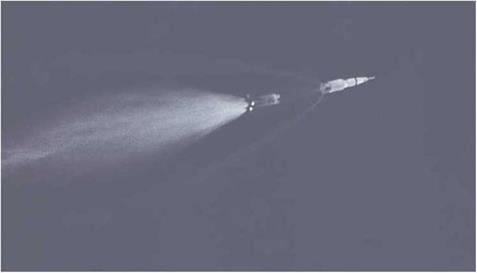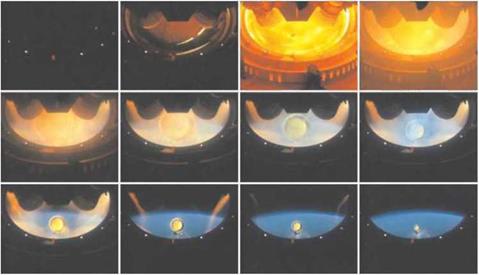SECOND STAGE
The first staging event: cutting up the ship
Theory had demonstrated early on that a rocket constructed using a series of modular stages would allow engineers to loft payloads into space with much greater efficiency than trying to use a single stage, at least with current technology. The Saturn V was therefore built as a three-stage vehicle. When each stage was exhausted, it was cut adrift to coast on alone to its fate while a fresh stage took up the task of getting the spacecraft into orbil and thereafter to the Moon. The moment when one stage Look over from another was called staging, and was always a complex and carefully choreographed event controlled by the instrument unit’s computer and sequencers. In the space of a few seconds, a nearly exhausted stage had to be shut down in a controlled manner, physically separated then retarded while the propulsion system of the fresh stage was ignited and brought up evenly to full thrust. The manner in which this was achieved depended on the specific staging event.
Before the first staging event could Lake place that is. w’hen the S-IC gave way to the S-II – the final manoeuvre of the tilt sequence had to be made. Throughout most of the S-IC’s burn, the Lilt sequence had been gently rotating the vehicle towards the horizontal. However, at staging, the Saturn vehicle would to all intents and purposes be cut in half. As it was undesirable to have two very large pieces of hardware in a state of rotation next to each other, the final manoeuvre of the tilt sequence was till arrest. This minimised the rotation of the stack so that the S-IC and the interstage ring between the two stages could depart without significant risk of cither of these disposed items coming into contact with the engine bells of the S-
II.
Once the rocket’s attitude had stabilised, sensors in the propellant tanks signalled to the Saturn V’s computer that depletion was near, at which point the four outboard engines were shut down and Timebase 3 began. The logic programmed into the sequencers ensured that this new timebase could only start
|
Apollo ll’s S-IC stage falls away as the S-II takes over. (NASA) |
if Timebase 2 (activated at centre-engine shutdown) had already occurred to avoid the possibility of it being accidentally started on the ground, for it coordinated all the events relating to staging and the control of the S-II stage for the entire duration of its burn.
The separation of the S-IC and the S-II stages was technically known as a dual plane separation since the vehicle was to be cut around its girth in two places on either side of a ring called the interstage. This ring or skirt was a 5.5-metre section of the Saturn V’s skin which acted as a spacer between the first and second stages to accommodate the latter’s engines. It had been decided that the ring should not separate with the S-IC, lest any rotation between the stages caused it to damage the engines. On the other hand, its long-term presence was likely to cause overheating problems around the S-II engines. The solution was to separate the SIC first, wait 30 seconds until the second stage was firing smoothly and rapidly accelerating, and then cut the skirt free. Failure of the skirt to separate was considered sufficiently serious to abort the mission, since to carry so much extra weight would have seriously degraded the stage’s performance. The skirt did fail to separate on the last Saturn V to fly – the unmanned launch of the Skylab orbital workshop to orbit in May 1973. Fortunately, the S-II tolerated the heat and the lower payload weight allowed it to reach orbit with a mere 2.5 per cent of its propellant remaining.
Cutting the skirt was not the only event involved in staging. Immediately after the first stage had shut down, two opposing sets of solid-fuel rockets ignited to pull the two halves of the Saturn apart. Up to eight forward-firing retro rockets were mounted in the conical fairings at the base of the first stage and a similar number of rearward-firing ullage rockets were fitted to the outside of the skirt. Ullage is a
|
The moment an S-IC stage falls away is caught by an onboard camera. (NASA) |
brewer’s term for the space in a bottle or cask that is left unfilled. When applied to rocketry, it refers to the portion of a propellant tank’s volume that is filled with gas. When starting a liquid-fuelled rocket engine, it is usually unwise to allow gas from the tank to enter the engine pumps. However, when the first stage engines shut down, the rocket was temporarily in freefall and the liquid in the S-II’s propellant tanks was free to slosh around. Designers eliminated the problem of gas-filled voids entering the engines by using ullage rockets to settle the contents of the tanks prior to second-stage ignition. Simultaneously with the ignition of the solid rockets, an explosive cord at the top of the S-IC was detonated to cut the skin across the first separation plane and cast loose the dead weight of the useless stage from the rest of the rocket. For the final three heavily loaded Apollo missions, the Saturn V’s payload capability was improved by deleting of some of the retro rockets on the S-IC and all of the ullage rockets on the skirt. By this point, the conservative engineers under von Braun had gained enough experience to know what was really working and what added little to their creation’s performance.
One second after the first stage was jettisoned, the five J-2 engines of the S-II stage were commanded to start. The momentum of the empty first stage caused it to continue upwards in a ballistic arc for some time, then fall into the Atlantic Ocean some 650 kilometres from the launch site in an area of sea cleared of shipping. 29 seconds after S-II engine start (30 seconds after S-IC separation) – a period deemed sufficient for the smooth running of the second stage to be established – explosive cord cut the skin around the top of the interstage ring to allow it to fall away from the accelerating second stage.
Frank Borman was an all-business astronaut who, during a post-flight debriefing, summed up the violence of Apollo 8’s first staging event on his terms. The S-IC/S-II
separation was nominal; the crew was thrown forward in their seats, as you would expect in a staging. Then the g – load was shifted from four to about one. Consequently, you noticed the change in thrust quite distinctly. There was some indication of light flash at staging through the hatch window.”
 Other crews were less reserved in their reaction, especially in the moments after the experience. ‘‘Man, that staging was quite a sequence!” exclaimed Tom Stafford, Apollo 10’s commander. Shortly afterwards, his LMP Eugene Cernan asked of mission control, “Charlie, are you sure we didn’t lose Snoopy [their lunar module] on that staging?” Charlie Duke replied “No, I think Snoopy is still there with you. You’re looking good.”
Other crews were less reserved in their reaction, especially in the moments after the experience. ‘‘Man, that staging was quite a sequence!” exclaimed Tom Stafford, Apollo 10’s commander. Shortly afterwards, his LMP Eugene Cernan asked of mission control, “Charlie, are you sure we didn’t lose Snoopy [their lunar module] on that staging?” Charlie Duke replied “No, I think Snoopy is still there with you. You’re looking good.”
On Apollo 13, rookie Fred Haise was completely unprepared for the shock. “Man, I’ll tell you, that first stage. When that shut down, man, I thought I was going through the instrument panel. I was so surprised.” His commander Jim Lovell was already a veteran of the Saturn V. “I should have warned you,” he told his crewmate.
Ken Mattingly, on the other hand, had been warned. “I was well braced for it. I’m sure glad I was. That really gets your attention!” Sitting next to him was John Young, commander of Apollo 16, who had flown the Saturn V previously and knew from experience what to expect. He was supposed to be gripping a T-shaped abort handle which, by a simple twist counter-clockwise, would have brought the mission to an end. He was worried by the possibility of the event’s violence causing him to unintentionally operate the handle. “I was holding on to the bottom of the T-handle, at that point, because I sure didn’t want to do the wrong thing.”
Part of what made the first-stage separation so exciting was the launch vehicle’s entire structure being unloaded. Up to the point when the remaining four F-l engines were shut down, the 110-metre length of the Saturn had been slightly compressed by the 4-g acceleration they imparted. When their force was suddenly removed, the structure tried to bounce back to an unloaded state like a spring. Later Apollo crews were prepared for the shock, as Ed Mitchell on Apollo 14 noted: “When the outboards cut off, as we had previously been briefed and as previous crews had discussed, there was a sharp unloading. I
expected to be thrown against the instrument panel, and I had my hands out to brace against it. But it was not as much as I expected.’’
Apollo 17’s launch was distinctive by being the only night-time launch of a Saturn V. and its commander Eugene Cernan. who was also having his second ride on the big rocket, commented in his debrief on some effects at staging that he never saw on his first ride: “I don’t think it’s ever been recorded on a daylight launch before, but as soon as the S-IC shut down, the trailing flame of the S-IC overtook the spacecraft when we immediately went into that zero-g condition. And. for just a second, as the S-II lit off, we went through the flame. It was very obvious. We could see it out of both windows. 1 particularly could see it out of the left-hand window. It was not a smoke; it was not an orange fireball; it was just a bright yellow fire of the trailing flame of the S-IC; and it happened for just a split second.” In fact, the Apollo 15 commander David Scott did notice something similar when he commented to his crewmates soon after his mission’s daylight staging: "Okay. I got the big fireball going by at staging. I don’t know whether you saw it or not. That beauty really goes.”
Jack Schmitt’s recollection of the Apollo 17 staging echoed just about everyone else’s. "Just pushing 4 g on the thing and it quits just like that. I was prepared for it because Gene had said. ‘Hey. brace yourselves because it is going to happen.’ and it happened all right. It just fiat quit when we went from 4 g to zero.” Cernan then added a full stop to the crews’ experiences of the S-IC. “The great train wreck.”












